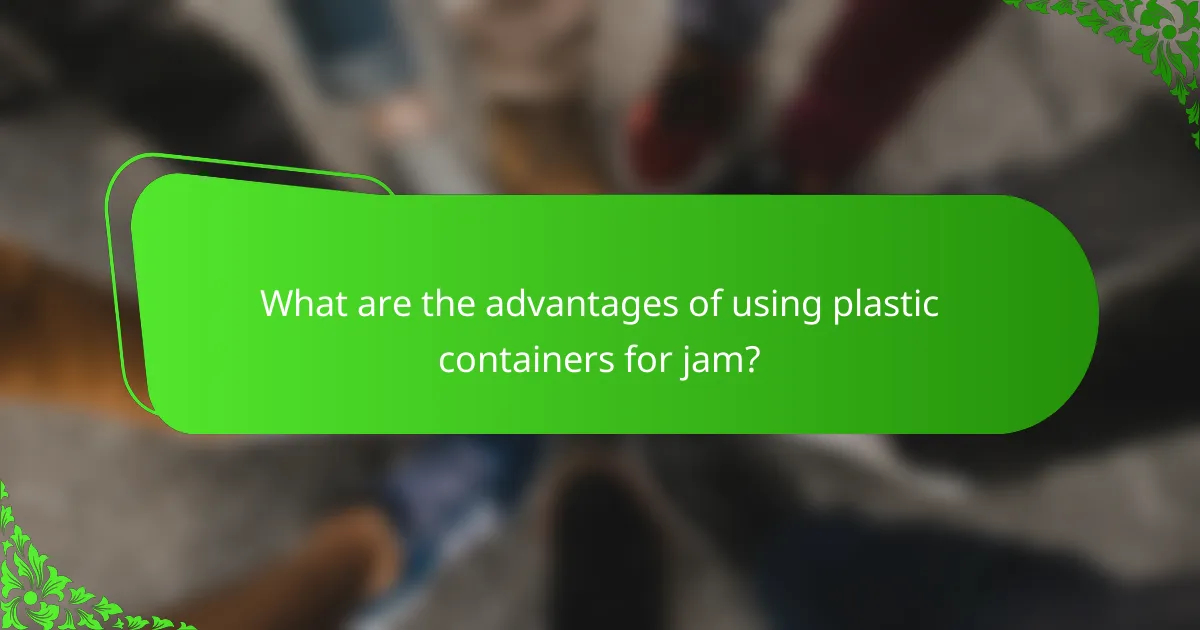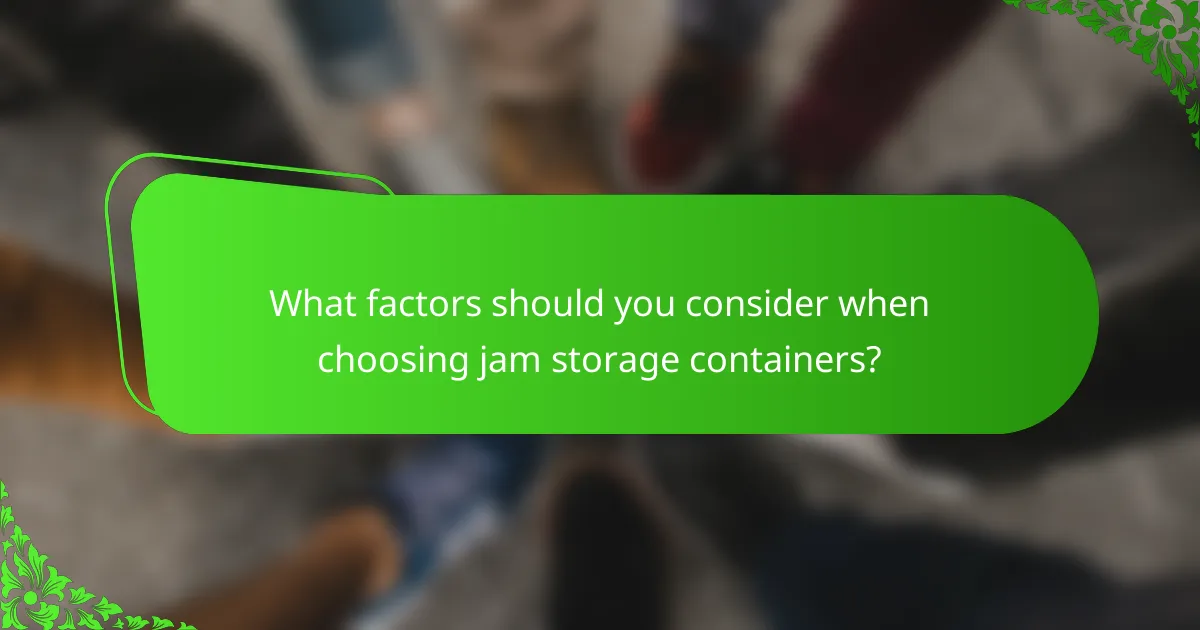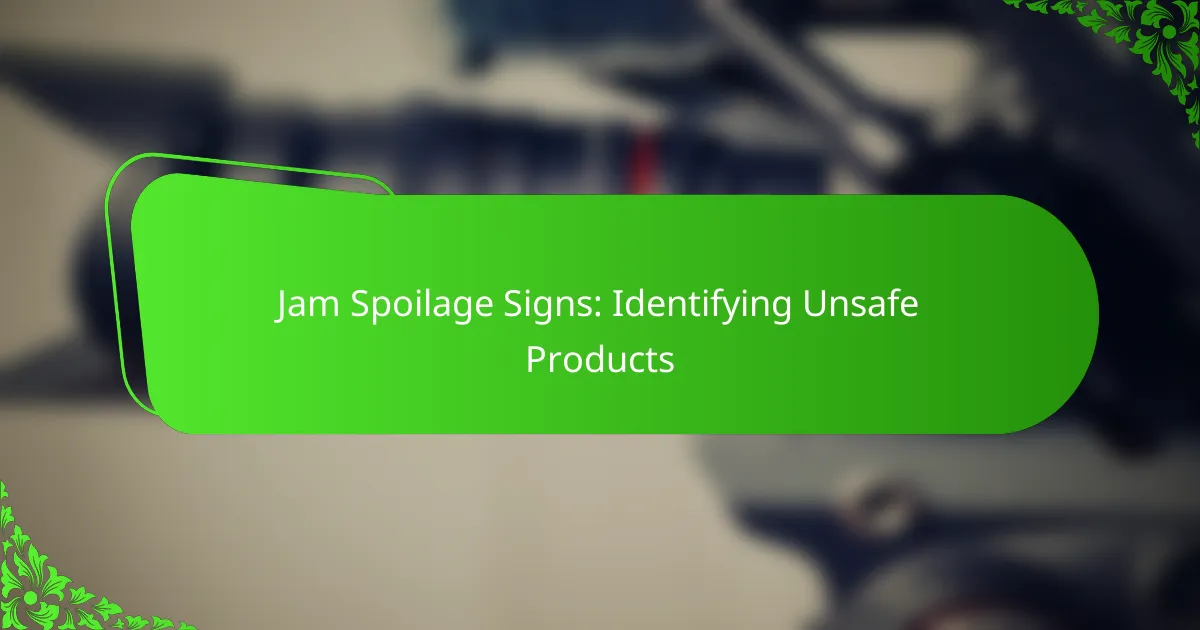When it comes to storing jam, the choice between glass and plastic containers can significantly impact flavor preservation and convenience. Glass containers are favored for their ability to maintain the jam’s aroma and extend shelf life, while plastic options provide lightweight, affordable, and versatile solutions. Ultimately, your decision will depend on whether you prioritize taste or practicality in your jam storage needs.

Which containers are better for jam storage: glass or plastic?
Glass containers are generally considered better for jam storage due to their ability to preserve flavor and aroma, while plastic containers offer convenience and durability. Choosing between them depends on your priorities, such as taste preservation or ease of handling.
Glass containers preserve flavor and aroma
Glass containers are non-porous and do not absorb odors or flavors, making them ideal for storing jam. This characteristic helps maintain the original taste and aroma of the jam over time, ensuring a fresher experience when you open the jar.
Additionally, glass is impermeable to gases, which means that the quality of your jam remains intact without the risk of contamination from external elements. For best results, store glass jars in a cool, dark place to further enhance preservation.
Plastic containers are lightweight and shatterproof
Plastic containers are significantly lighter than glass, making them easier to handle, especially when transporting or stacking. Their shatterproof nature reduces the risk of breakage, which is particularly beneficial for families with children or for outdoor activities.
However, while plastic is convenient, it may not provide the same level of protection against air and moisture as glass. For short-term storage or casual use, plastic can be a practical choice.
Glass containers are recyclable and eco-friendly
Glass is 100% recyclable and can be recycled indefinitely without losing quality. This makes glass containers a more sustainable option for jam storage, aligning with eco-friendly practices and reducing landfill waste.
Choosing glass not only benefits the environment but also supports a circular economy. Many communities offer recycling programs that accept glass, making it easy to dispose of responsibly.
Plastic containers may leach chemicals over time
One concern with plastic containers is the potential for chemical leaching, especially when exposed to heat or acidic substances like jam. Certain plastics can release harmful substances into food, particularly if they are not labeled as food-safe.
To minimize risks, look for BPA-free plastic containers and avoid using them for long-term storage of acidic foods. If you choose plastic, consider using it for short-term storage and transferring your jam to glass for long-term preservation.

What are the benefits of using glass containers for jam?
Glass containers offer several advantages for jam storage, including preserving flavor and extending shelf life. Their non-reactive nature and aesthetic appeal make them a preferred choice for both home cooks and gift-givers.
Non-reactive material ensures taste integrity
Glass is a non-reactive material, meaning it won’t interact with the acids or sugars in jam. This property helps maintain the original flavor and quality of the jam over time, preventing any off-tastes that can occur with certain plastics.
When storing acidic foods like jam, glass containers provide a safe environment that keeps the taste pure. This is particularly important for homemade jams, where flavor is a key selling point.
Longer shelf life for homemade jams
Using glass containers can significantly extend the shelf life of homemade jams. Properly sealed glass jars can keep jams fresh for up to a year when stored in a cool, dark place. In contrast, plastic containers may allow for quicker spoilage due to potential permeability and less effective sealing.
To maximize shelf life, ensure that glass jars are sterilized before filling them with jam. This practice reduces the risk of contamination and helps preserve the jam’s quality for longer periods.
Attractive presentation for gifting
Glass containers are visually appealing, making them an excellent choice for gifting homemade jams. Their clarity showcases the vibrant colors and textures of the jam, enhancing the overall presentation.
Consider using decorative glass jars with unique shapes or labels to personalize your gifts. This added touch can make your homemade jam more enticing and memorable for recipients, whether for holidays or special occasions.

What are the advantages of using plastic containers for jam?
Plastic containers offer several advantages for jam storage, including affordability, lightweight design, and a range of sizes. These features make them a practical choice for both home cooks and commercial producers.
Cost-effective and widely available
Plastic containers are generally less expensive than glass options, making them an attractive choice for those looking to save money. They are widely available in supermarkets and online, which means you can easily find the right type and size for your needs.
In many regions, plastic containers can be purchased in bulk, further reducing the cost per unit. This is particularly beneficial for those who make large quantities of jam and need multiple containers.
Lightweight and easy to handle
One of the key benefits of plastic containers is their lightweight nature, which makes them easy to transport and handle. This is especially useful for home canners who may need to move jars around during the jam-making process.
Additionally, the lightweight design reduces the risk of breakage, making plastic a safer option for families with children or for outdoor events where glass could be hazardous.
Variety of sizes for different batch quantities
Plastic containers come in a wide range of sizes, accommodating various batch quantities of jam. Whether you are making small test batches or large quantities for sale, you can find a suitable container.
This variety allows for flexibility in storage and portioning, making it easier to manage your jam supply. For example, you might choose smaller containers for gifts and larger ones for personal use or storage in the pantry.

How do glass and plastic containers compare in terms of safety?
Glass containers are generally considered safer for storing jam compared to plastic containers. This is due to the absence of harmful chemicals in glass, which can leach into food, especially when exposed to heat or acidic contents.
Glass is free from harmful chemicals
Glass is made from natural materials like sand, soda ash, and limestone, making it inert and non-reactive. This means that it does not release any harmful substances into food, ensuring that your jam remains uncontaminated.
Additionally, glass containers are dishwasher safe and can be reused many times without degrading, which contributes to their safety and sustainability. They are also suitable for canning, as they can withstand high temperatures without risk of melting or warping.
Plastic may contain BPA or other additives
Many plastic containers, especially older ones, can contain bisphenol A (BPA) and other chemical additives that may leach into food. BPA has been linked to various health concerns, including hormonal disruptions, making it a significant consideration when choosing storage options for jam.
When selecting plastic containers, look for those labeled as BPA-free and made from safer plastics like polyethylene or polypropylene. However, even BPA-free plastics can still contain other additives that may not be safe, so glass is often the preferred choice for long-term food storage.

What factors should you consider when choosing jam storage containers?
When selecting jam storage containers, consider factors such as the type of jam, intended use, storage duration, and conditions. These elements will influence whether glass or plastic is the better choice for your needs.
Type of jam and intended use
The type of jam plays a significant role in determining the best storage container. For high-acid jams, such as those made from berries, glass containers are often preferred due to their non-reactive nature. Plastic containers may be suitable for lower-acid jams but can absorb flavors and odors over time.
Additionally, consider how you plan to use the jam. If you intend to gift or showcase the jam, glass jars can provide an appealing presentation. For everyday use, plastic containers may offer convenience and lighter weight.
Storage duration and conditions
Storage duration is crucial when choosing between glass and plastic. Glass containers are generally better for long-term storage, as they provide an airtight seal and do not degrade over time. Plastic containers may be more suitable for short-term use, especially if you plan to consume the jam quickly.
Consider the storage conditions as well. If you will keep the jam in a refrigerator or pantry, glass can withstand temperature fluctuations better than plastic. However, if you need to transport the jam frequently, lightweight plastic may be more practical.










